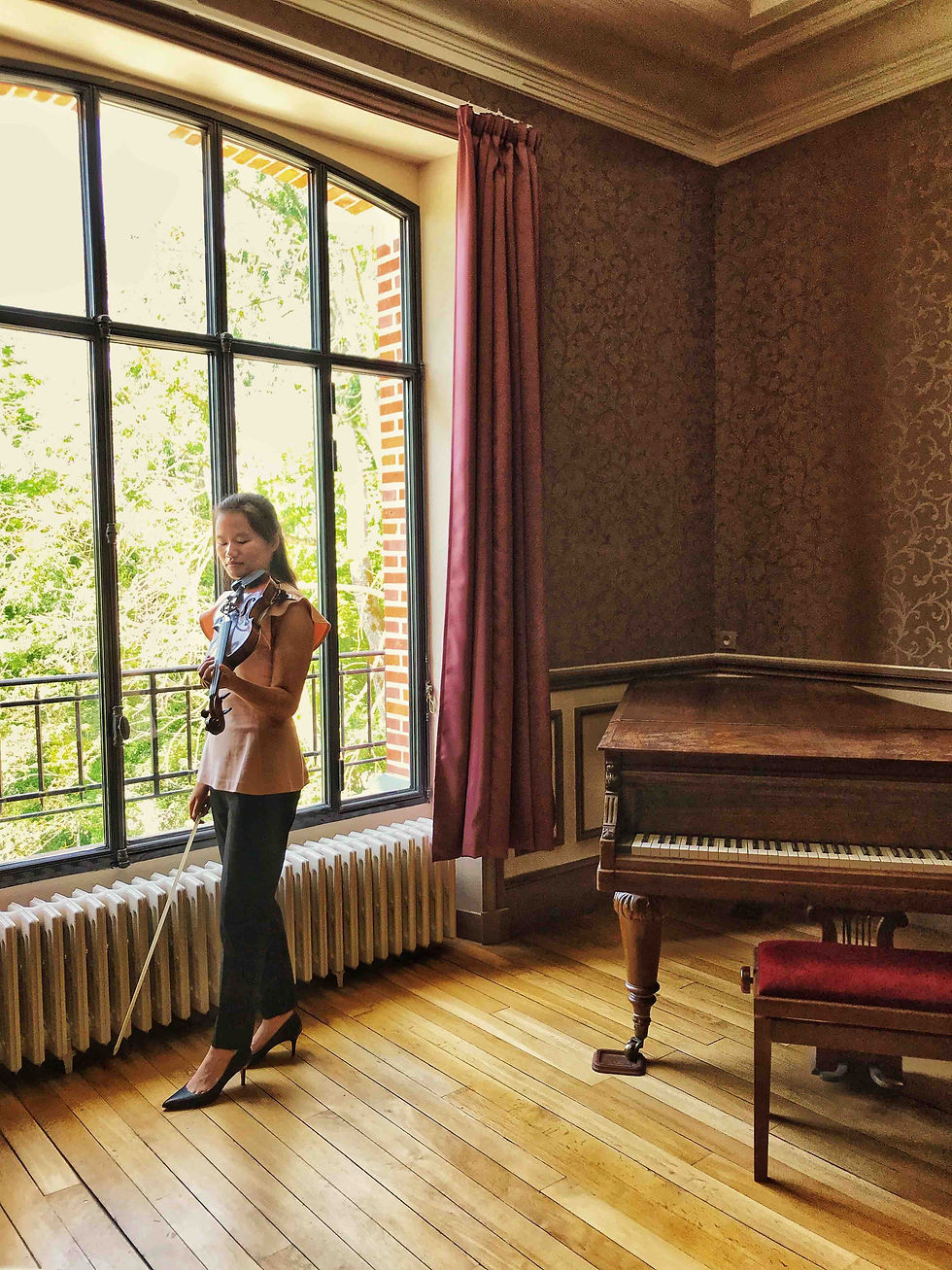Natalie Darst Xia: "we were practicing to become masters".
- François Bibonne

- 8 sept. 2019
- 4 min de lecture
Dernière mise à jour : 9 janv. 2020
Tradition: A word that came to have multiple definitions for me and proceeded to define my first summer in France. As I began my studies at the 2019 Ecoles d’Art Américaines de Fontainebleau session, I was very excited for the unique opportunities that this renowned festival had to offer young artists. Although I had friends who had previously attended and who spoke enthusiastically about the program, I was truly not prepared for how the Fontainebleau Tradition would change my musical path.

I was truly not prepared for how the Fontainebleau Tradition would change my musical path.
Located in the beautiful Château de Fontainebleau, just southeast of Paris, the music festival gives the students opportunities to practice and perform inside the Château’s exquisite state rooms and chapelles (with stunning acoustics), to work with the renowned music faculty, and to collaborate not only with the incredibly gifted and dedicated musicians who would later become some of my closest friends, but also with the composition and architecture students whose daily projects were inspiring to observe. We directly witnessed the way that architecture and music both express the inexpressible by connecting abstract ideas to create one unified result. But perhaps the most unique aspect that sets this festival apart from any other in my experience is the artistic relationship between the faculty and the students.
I experienced a turning point in my musical life.
The director of the Fontainebleau School, Diana Ligeti, and the music faculty, who are themselves steeped in the French musical tradition, strove to create an environment that challenged and encouraged the students to attain a new level of musicianship by constantly giving us fresh ideas, pushing us to take risks, and providing performance opportunities in order to continue cultivating our skills. And yet through these intense weeks of instruction, the faculty not only encouraged but respected the students to constantly ask questions and to come up with solutions to execute our own ideas. Although I was incredibly excited about the new information I was acquiring, it was not until week three on the day of my chamber group’s Audition, that I experienced a turning point in my musical life. During one of the most challenging and exhilarating performances in my studies, I understood the core success of the Fontainebleau Tradition: we were not practicing to become better students. We were practicing to become masters.

Another unique aspect about Fontainebleau is the many performance opportunities offered to the participants. For four weeks, I collaborated with five wonderful musicians on the first movement of the Ravel String Quartet and the complete Dvorak Piano Quintet. Throughout the summer, our chamber group had wonderful opportunities to work intensively with the chamber faculty, and to perform our chamber works at various venues including the Durand Publishing House (where we saw and played on Ravel’s piano), and in the beautiful performance spaces inside the Château. In the final week of the festival, we had the pleasure of performing in a concert hosted by Fontainebleau and the Fondation des Etats-Unis at the Fondation’s Grand Salon in Paris. By the end of our time together, we could not get through a performance without smiling because of the musical trust, energy, and joy that each musician brought to the group.
[...]we were encouraged by the faculty and the administration to get out of the practice room and absorb the ambiance, sounds, history, and language of the French culture.
Like many of my colleagues, this was my first time studying in France, and while the first instinct for a musician at a music festival is to lock themselves in their room to practice, we were encouraged by the faculty and the administration to get out of the practice room and absorb the ambiance, sounds, history, and language of the French culture. With the help of the wonderful Fontainebleau staff, the students were offered numerous opportunities to attend activities that would enhance our experiences and complement what we were learning musically. However, with so many interesting activities happening every day, it was hard to choose which ones to attend. And yet, whenever someone mentioned the magic phrase “it’s a Fontainebleau tradition,” we knew that was a sign that we were in for an experience that was not to be missed! From watching a documentary about the inspiring Nadia Boulanger and attending the architect students’ Saturday juries, to going on the annual Fontainebleau forest hike and sitting on the L’Ecailler du château’s sidewalk café with friends (and some good wine) while watching the moon rise above the Château, every experience served its purpose in allowing us to draw inspiration from the daily beauty of French life.
When learning a new musical style, whether it is in the German, French, Viennese styles, most young musicians rely upon historical research, recordings, live concerts, and private teachers in order to grasp this new musical language. However, like learning a spoken language, there is nothing that can compare to the complete immersion into the culture of that language’s home. And that is why I was drawn to studying at Fontainebleau, a unique site of French history, art history, and architecture.
[...]Fontainebleau is an experience that will stay with me for the rest of my life.
To take part in a history like that of Fontainebleau is an experience that will stay with me for the rest of my life. From the lessons and coachings with the phenomenal faculty, to being surrounded by wonderful friends and the surreal beauty of the Château, the festival succeeds in its purpose of imparting to its students the Fontainebleau Tradition.






Commentaires